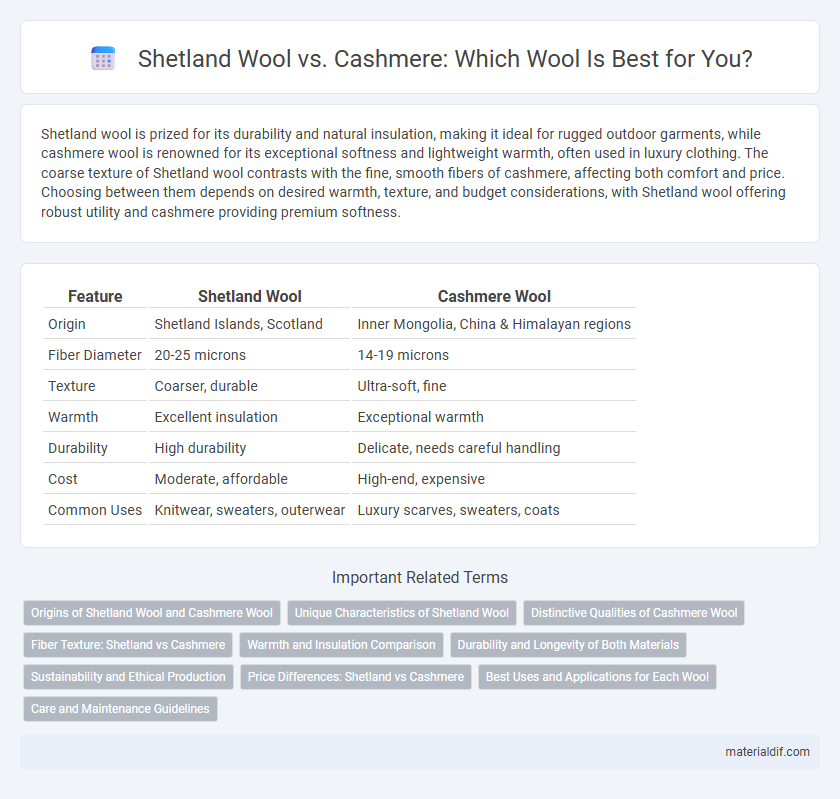Shetland wool is prized for its durability and natural insulation, making it ideal for rugged outdoor garments, while cashmere wool is renowned for its exceptional softness and lightweight warmth, often used in luxury clothing. The coarse texture of Shetland wool contrasts with the fine, smooth fibers of cashmere, affecting both comfort and price. Choosing between them depends on desired warmth, texture, and budget considerations, with Shetland wool offering robust utility and cashmere providing premium softness.
Table of Comparison
| Feature | Shetland Wool | Cashmere Wool |
|---|---|---|
| Origin | Shetland Islands, Scotland | Inner Mongolia, China & Himalayan regions |
| Fiber Diameter | 20-25 microns | 14-19 microns |
| Texture | Coarser, durable | Ultra-soft, fine |
| Warmth | Excellent insulation | Exceptional warmth |
| Durability | High durability | Delicate, needs careful handling |
| Cost | Moderate, affordable | High-end, expensive |
| Common Uses | Knitwear, sweaters, outerwear | Luxury scarves, sweaters, coats |
Origins of Shetland Wool and Cashmere Wool
Shetland wool originates from the Shetland Islands in Scotland, known for its fine, resilient fibers produced by native Shetland sheep adapted to harsh climatic conditions. Cashmere wool comes from the undercoat of Cashmere goats primarily found in the high plateaus of Mongolia, China, and Nepal, prized for its exceptional softness and thermal insulation. The distinct geographic origins contribute to the unique textures, durability, and warmth characteristics of Shetland and Cashmere wool.
Unique Characteristics of Shetland Wool
Shetland wool is renowned for its exceptional durability and natural resilience, making it ideal for outerwear that withstands harsh weather. Its fine crimp and loft provide excellent insulation while remaining lightweight, distinguishing it from the softer, more delicate fibers of cashmere. Unique lanolin content in Shetland wool offers water-repellent properties, enhancing its functionality compared to the luxury softness of cashmere wool.
Distinctive Qualities of Cashmere Wool
Cashmere wool is renowned for its exceptional softness and lightweight warmth, derived from the fine undercoat fibers of Cashmere goats, distinguishing it from the coarser texture of Shetland wool. Its luxurious insulation quality and natural breathability make Cashmere ideal for high-end garments requiring both comfort and elegance. Unlike the robust, durable Shetland wool, Cashmere fibers are finer and less elastic, necessitating delicate care to maintain their delicate structure and longevity.
Fiber Texture: Shetland vs Cashmere
Shetland wool features a coarse and resilient fiber texture, providing durability and natural insulation ideal for outerwear and hand-knit garments. Cashmere wool exhibits a notably finer, softer, and smoother fiber texture, offering luxurious softness and superior warmth suitable for high-end apparel. The distinct difference in fiber diameter, with Cashmere fibers typically measuring 14-19 microns versus Shetland's thicker 25-30 microns, accounts for the varying tactile qualities and fabric performance.
Warmth and Insulation Comparison
Shetland wool provides excellent insulation due to its dense, coarse fibers, which trap air effectively, making it highly warm and durable for cold climates. Cashmere wool, sourced from the undercoat of cashmere goats, offers superior softness and lighter warmth while maintaining impressive insulation through finer fibers that retain heat without bulk. Both wools excel in thermal properties, but Shetland wool is preferred for robust insulation in harsher conditions, whereas cashmere is valued for lightweight warmth and comfort.
Durability and Longevity of Both Materials
Shetland wool is renowned for its exceptional durability and resilience, making it ideal for garments that withstand heavy wear and harsh weather conditions. Cashmere wool, while luxuriously soft and lightweight, tends to be less durable and requires more delicate care to maintain its longevity. The natural fiber structure of Shetland wool contributes to its robustness, whereas cashmere's fine fibers, although warm, are more prone to pilling and wear over time.
Sustainability and Ethical Production
Shetland wool is renowned for its sustainability due to the traditional, low-impact farming methods used by Shetland sheep farmers, which promote biodiversity and reduce chemical use. Cashmere wool often faces criticism for overgrazing by cashmere goats, leading to desertification and environmental degradation in key regions such as Mongolia and China. Ethical production of Shetland wool emphasizes animal welfare and local craftsmanship, contrasting with some cashmere production practices that lack transparency and exploitative labor conditions.
Price Differences: Shetland vs Cashmere
Shetland wool is significantly more affordable than cashmere, with prices typically ranging from $20 to $50 per yard compared to cashmere's $100 to $400 per yard. This price disparity stems from Shetland wool's widespread availability and the labor-intensive, rare process required to produce cashmere. Consumers often choose Shetland wool for budget-friendly durability, while cashmere is prized for its luxurious softness and exclusivity despite the higher cost.
Best Uses and Applications for Each Wool
Shetland wool, known for its durability and moisture-wicking properties, is ideal for rugged outdoor garments like sweaters, hats, and gloves that require warmth and resilience. Cashmere wool, prized for its softness and fine texture, excels in luxury apparel such as scarves, lightweight sweaters, and high-end coats offering exceptional comfort and insulation. Choosing Shetland wool suits functional and hard-wearing clothing, whereas cashmere is best for premium, delicate pieces where softness and elegance are paramount.
Care and Maintenance Guidelines
Shetland wool, known for its resilience and durability, requires gentle hand washing in cold water with mild detergent to maintain its natural lanolin properties and prevent shrinkage, while avoiding tumble drying is crucial to preserving its structure. Cashmere wool demands even more delicate care, preferring dry cleaning or hand washing with special cashmere shampoo in lukewarm water, followed by flat drying to retain softness and prevent fiber damage. Both fibers benefit from storage in breathable containers with cedar balls or lavender sachets to deter moths and preserve their luxurious textures over time.
Shetland Wool vs Cashmere Wool Infographic

 materialdif.com
materialdif.com